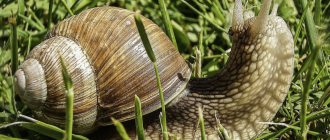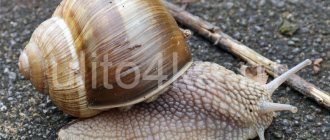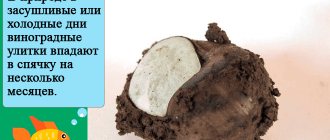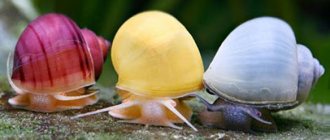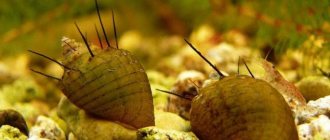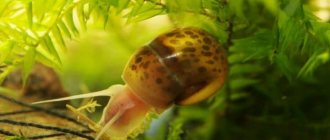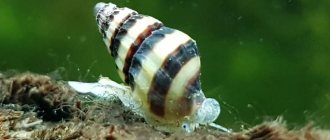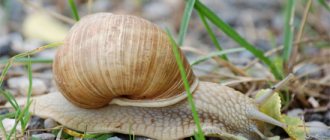- Wild animals
- >>
- Other animals
The grape snail is one of the most common terrestrial gastropods that can be found in our latitudes. These creatures can be found everywhere; snails live on green bushes in forests and parks, gardens and vegetable gardens. These snails are very hardy, reproduce quickly and easily fill large areas. Grape snails are considered the largest snails that live in Europe. Since ancient times, these animals have been eaten, since these mollusks were always available, and their meat is very healthy.
Origin of the species and description
Photo: Grape snail
Helix pomatia or Grape snail is a terrestrial mollusk belonging to the class of gastropods, order of stalked animals, family of Holicides. Genus Helix species Helix pomatia grape snail. This snail is also popularly called Apple snail or Apple snail, Moon snail or Burgundy snail. Snails are one of the most ancient creatures on our planet.
Back in the Cretaceous period of the Mesozoic era, snails already inhabited our land. The oldest remains of representatives of gastropods are 99 million years old. The remains were found in Burma during amber excavations. The ancient mollusk even preserved its soft tissues, due to the fact that the snail got into amber and could not get out of it.
Video: Grape snail
The species Helix pomatia was first described by the Swedish naturalist Carl Linnaeus in 1758. The grape snail is considered the largest snail in Europe; the adult shell size is up to 46 mm, the shell width is up to 47 mm. An adult may weigh up to 45 grams. The grape snail is a large gastropod mollusk from the order Stem-Eyed.
The body of the mollusk is asymmetrical. The head is clearly defined. The head has two pairs of tentacles and eyes. The shell is curved in the form of a spiral and has 4.5 turns. The color of the grape snail is uniform yellowish-orange. This mollusk breathes air using its lungs. Pneumostome - a small breathing hole located between the folds of the mantle and opens every minute.
Albino
In November 2011, a rare albino mollusk with a translucent white body and a golden-beige spiral-shaped shell was discovered in Kahurangi National Park (New Zealand). It turned out to be the snail Powelliphanta hochstetteri hochstetteri.
This gastropod looked to be at least 10 years old, which is very surprising. Albinos do not live long because of their bright color, which is clearly visible to predators. This coloring is associated with genetic disorders, which leads to a lack of skin pigmentation.
Appearance and features
Photo: What a grape snail looks like
Grape snails are very large. The shell of an adult specimen is from 3.5 to 6 cm in diameter. The entire mollusk fits into the shell. The body of the mollusk has a leg and a head; the head has 2 eyes and tentacles. The internal organs are protected by a mantle, and part of this mantle is visible from the outside. Body length is from 3.5 to 5.5 cm. The body is elastic, which means that the snail can stretch out greatly. The color of the body is the same as on the shell, usually yellow and brown or beige-brown.
The entire body of the snail is evenly covered with wrinkles, and most individuals also have a pattern on their body. Droplets of moisture are retained in the wrinkles on the leg. The shell is large, curved in the form of a spiral and has 4-5 turns. The shell is disc-shaped, twisted to the right, yellow-brown in color. Along the entire length of the first three whorls of the shell there are 5 light stripes and 5 dark stripes.
Interesting fact: The color of grape snails can change depending on its diet. There are 2 pairs of tentacles on the snail's head above the mouth. The labial tentacles are short, from 2 to 4.5 mm. The eye tentacles are long from 1 to 2.2 cm. The eyes are located on the eye tentacles. Snails have poor vision; they are able to see objects only at a distance of 1 cm from the eyes of the mollusk. In addition, all snails are color blind; they cannot distinguish colors - this is due to the fact that all the receptors responsible for vision have one photo pigment.
The internal structure of the grape snail is the same as that of other snails. The digestive system consists of an ectodermal foregut and an ectodermal midgut. The snail breathes with its lungs. The heart is surrounded by pericardium and consists of a ventricle and a left-sided atrium. The heart pumps colorless blood. The nervous system consists of several nerve ganglia.
Snails move slowly, using their legs. During movement, the snail contracts the muscles of its leg and slides along the surface, constantly pushing off from it. During movement, a special liquid, mucus, is released from the mollusk, which reduces friction. The snail slides easily through the mucus. At the same time, the snail is firmly attached to the surface, so it can easily crawl as if on a horizontal plane. The same goes for vertical surfaces. Snails live quite a long time. In the wild, the average lifespan of grape snails is 6-8 years, however, many individuals live much longer. There are snails that live for 25-30 years.
Interesting fact: Snails are capable of regeneration; if they lose part of their body, the snail is able to regrow it in just a couple of weeks.
Useful material
Biologists have calculated that the average snail is 80% water, 15% protein and 2.4% healthy fat. In particular, the meat of these shellfish contains essential fatty acids, calcium, iron, selenium, and magnesium. They are rich sources of vitamins A, E, K and B12.
Snails are an ideal option for a fat-burning diet. The calorie content of a 100-gram serving does not exceed 90 kcal. At the same time, the delicacy will provide the maximum amount of proteins (approximately 16.5 g) and the minimum dose of carbohydrates (no more than 2 g).
Regarding fats, nutritionists have calculated that a serving of gastropods contains less than 2 g of fat. But the main advantage is not even this, but the high content of omega-3 fatty acids. For example, snails contain eicosapentaenoic acid (almost 120 mg per 100 g of product), which is one of the main components of omega-3. Cardiologists recommend consuming 250 mg of fatty acids from shellfish daily to reduce the risk of cardiovascular disease.
If we talk about the vitamin and mineral composition, then 100 g of snails is:
- 3.5 mg of iron (which is more than in beef);
- 250 mg magnesium (which is much more than in beef, pork, chicken or fish);
- 382 mg potassium;
- 272 mg phosphorus;
- 70 mg sodium;
- 10 mg calcium;
- 1 mg zinc;
- 0.4 mg copper;
- 27.5 mcg selenium;
- 0.5 mcg vitamin B12;
- 0.1 mg vitamin B6;
- 100 IU vitamin A;
- 5 mg vitamin E;
- 0.1 mcg vitamin K;
- 0.1 mg riboflavin;
- 1.4 mg niacin;
- 6 mcg folic acid;
- 65 mg choline.
Where does the grape snail live?
Photo: Grape snail in Russia
Initially, the homeland of these snails is Central and South-Eastern Europe. Today, the habitat of these mollusks is extremely wide; the snails have spread throughout Europe; in Australia they were also brought to the southern part of America. People love to keep these snails as pets, and for this they are purchased all over the world.
Snails reproduce very quickly, bringing huge offspring, and easily colonize new places. People often unintentionally breed snails by throwing away excess eggs. Just 2 snails can produce enough offspring to destroy all the vegetation in a small garden. Due to damage to cultural crops, the import of grape snails is prohibited in many countries.
In the wild, these mollusks usually live in meadows, forests where there is a lot of vegetation covering the soil, and in parks and nature reserves. Grape snails also love to settle in gardens and orchards with limestone or chalk soil. The main thing for snails is the presence of lush green vegetation. Especially often, snails of this species attack the grapevine, eating large grape leaves, which is why they got their name. In gardens, these snails cause damage to vegetation by eating leaves.
Grape snails prefer humid and temperate climates. They do not like bright sunlight; during the daytime they hide from the sun under leaves and stones. At night they quietly crawl through plants, feeding on leaves. Snails overwinter in the same place where they live, hiding among stones, in the roots of trees and other secluded places and fall into suspended animation for the winter. They can stay there for up to 5 months.
Beneficial features
Hippocrates also wrote about the benefits of snails for human health. The ancient Greeks noticed that the mucus left by gastropods smoothes scars and is useful for treating skin diseases. Over time, scientists confirmed that Hippocrates was right. The mucus contains substances that act on humans as antioxidants and anti-inflammatory agents. In addition, the secretion secreted by snails is believed by researchers to be the only natural source of copper peptide, a substance that eliminates scars. The gastropod secretory fluid has also been observed to be effective against warts and age spots. In addition, gastropod mucus has been used since ancient times to treat bronchitis, whooping cough and other diseases of the respiratory system.
The meat of these mollusks contains a glycoprotein, and it is believed to have anti-cancer properties. Snail dishes are also considered beneficial for people with cardiac problems.
Top 5 benefits
Snails are an excellent source of lectin, which has anti-cancer properties and stimulates the immune system.- The mucus of these gastropods is rich in allantonin, collagen and elastin - components important for the treatment of skin diseases and bone fractures. Copper peptide from shellfish secretions helps smooth out scars.
- The secretion secreted by these mollusks is an important source of oligosaccharides. In addition, this liquid treats acne, moisturizes the skin, improves its color, and protects against adverse environmental influences.
- Sea snails contain a specific substance that is beneficial for people suffering from depression, Parkinson's disease or drug addiction.
- In the bodies of slugs with “houses”, scientists have discovered a substance that stimulates the production of dopamine (the so-called happiness hormone) in people with neurological disorders.
What does the grape snail eat?
Photo: Large grape snail
Grape snails are herbivores. They mainly feed on lush green leaves.
The diet of grape snails includes:
- dandelion;
- burdock;
- grape leaves;
- strawberry leaves;
- lungwort;
- cabbage;
- salad;
- sorrel;
- horseradish leaves;
- lettuce leaves;
- raspberry leaves;
- nettle and more than 30 species of various plants;
- vegetables and fruits.
To build up their shell, snails also need calcium salts; in the wild they can eat limestone. They do not disdain humus, which contains various minerals. In captivity, it is necessary to give snails special mineral supplements.
Domestic snails are fed fruits and vegetables. Snails love apples, zucchini, bananas, beets, cucumbers, pumpkins, melons, potatoes, and radishes. And also greens: dandelion leaves, beet and carrot tops, plant leaves. When feeding snails kept in a terrarium, the food is cut into very small pieces. Soaked bread is considered a special treat for snails, but it is best to give it in small quantities only as complementary food. The remains of spoiled food are removed, otherwise the snails may be poisoned. Snails are constantly hungry and do not feel full, so you need to give food in small portions. It is better to underfeed a snail than to overfeed it.
Now you know what to feed grape snails. Let's see how they live in the wild.
Water
Gill snails prefer to live in salt water. There are individuals that live in fresh water bodies. Snails with different shell colors have been bred under artificial conditions.
Helena
Inhabits the flowing waters of Southeast Asia. Loves rivers with muddy banks. Adapted well to life in aquarium conditions. The diameter of the shell does not exceed 20 millimeters. This snail can live for about two years. A distinctive feature is that it uses its fellow creatures as food. It also feeds on settled particles of fish food. Aquarists keep it to reduce the snail population in their tank. Helena prefers slightly salted water with medium hardness.
Ampoules
They are small representatives of the gastropod order. Ampullaria live in fresh water bodies of Europe. It has a special cavity divided into two parts. With its help, the snail breathes both underwater and on land. At home, individuals with a yellow shell color are popular. Its diameter sometimes reaches 7 centimeters. By nature it is omnivorous. In aquariums it feeds on algae particles and food debris that has settled to the bottom. The optimal water temperature is 20–25 degrees. Acidity and hardness must be maintained at a neutral level. Lack of microelements leads to the destruction of the shell. They lead an active lifestyle. They tend to reproduce frequently. Life expectancy in captivity is 1–2 years.
Features of character and lifestyle
Photo: Grape snail in nature
The grape snail is a calm, slow-moving animal leading a sedentary lifestyle. Settles in damp places, tries to be between thickets of grass and in bushes, where bright rays of sunlight do not reach. During the daytime it can hide under stones and in the shade of plants. The snail spends almost the entire day in its shell. At sunset, they calmly crawl through the grass and eat almost all the time. Snails love rain; after rain they like to crawl on slippery wet grass. During a drought, this mollusk falls into torpor, at which time the snail becomes lethargic, climbs into its shell and covers its entrance with a transparent film.
Snails are very slow; the maximum speed of movement of a snail is 7 cm per minute. winter. In autumn, when the air temperature drops to 17-12'C, the snail goes to winter. It overwinters in a special hole dug in the ground at a depth of 5-10 cm. The snail buries itself in the soil. Snails can remain in suspended animation for up to 5 months, during which time they lose a lot of weight; after waking up, the snail returns to its normal state within a couple of weeks. Waking up early can withstand the effects of freezing temperatures for a small amount of time.
Interesting fact: The snail shell is very strong, it can withstand pressure of up to 12.5 kg. The snail calmly burrows into the ground without fear of being crushed.
Behavior
The land snail is nocturnal. At the same time, she spends most of her time buried in the damp forest floor or hiding under a fallen tree. The mollusk goes outside on humid nights to feed on slugs, worms, and also to find a partner for mating.
Considering that the diet of these snails consists mainly of large worms, they do not need frequent meals. Therefore, they may not crawl out of their shelter for several days.
Social structure and reproduction
Photo: Grape snail in Belarus
Puberty in grape snails occurs at the age of 1-1.5 years. Snails have several reproductive peaks, the first in the spring immediately after waking up from hibernation - the end of March-June. The second breeding season occurs in early autumn. During the courtship ritual, the snail crawls rather slowly in a circle, sometimes raising the front part of its body. Stops as if looking for someone.
When a pair of such snails meet, they begin to stretch out one on top of the other, feel each other with their tentacles, and touch their soles. After some time, the snails fall to the surface, pressing their soles together in this state, they remain motionless for about 15 minutes. Later, the mating game resumes until one of the snails inserts a sexual organ into the other. During copulation, both snails act as both male and female. After copulation, the snails scatter in different directions.
Interesting fact: During mating, the snail receives sperm phones, which it can store for a whole year, until it finds favorable conditions for laying eggs.
To lay eggs, the snail forms a clutch by digging a hole 5-10 cm deep, and later compacting the soil to form the walls of the shelter. Sometimes clutches are created in natural shelters, for example, near plant rhizomes. At one time, the clutch contains 40 pearl-colored eggs. Laying eggs is a rather complex process for snails, and about a third of the snails die after leaving their offspring. The incubation period lasts about a month. The snails that hatch from the egg are a small version of the adult. They have an absolutely smooth and transparent shell with only 1.5 curls. On the 10th day, young snails leave their nest and go outside in search of food.
Nutrition
The New Zealand snail can be as large as an adult's fist. Therefore, smaller invertebrates that come into her field of vision sometimes have a very hard time. Despite its slowness, an earth snail, when going out to hunt at night, is able to quickly deal with an earthworm, slug or its smaller fellow.
From the outside, the process of a snail eating an earthworm looks like it is sucking spaghetti into its mouth. At the same time, the poor fellow is subjected to tissue scraping alive with a sharp “grater” - a radula, consisting of 6 thousand teeth. And at the same time he dies long and painfully.
Natural enemies of grape snails
Photo: What a grape snail looks like
Snails are quite defenseless creatures that many predators love to feast on.
Natural enemies of grape snails include:
- various predatory insects such as beetles, flies, crickets, centipedes.
- hedgehogs;
- shrews;
- mice;
- toads;
- frogs;
- lizards;
- birds;
- weasels and many other predators.
Grape snails can also be attacked by predatory snail species. Predators can easily chew through the strong shell or suck the snail out of its shelter. Many beetles and insects can crawl inside a shell through the breathing hole, catching it by surprise. Snails are also often parasitized by various small worms.
Snails can transmit parasitic diseases to pets and livestock, which may eat the snail. In addition to wild predators, snails are also used as food by humans. In many countries, snails are bred to be eaten. Grape snail meat is very nutritious, contains a large amount of protein and vitamin B12.
Grape snails are also susceptible to colds, especially after emerging from hibernation; they can withstand the cold, but for a short time, and quickly catch a cold if they do not hide in shelter in time. In addition, snails cannot tolerate bright sunlight; during drought they try to hide in the shade. Deforestation and urbanization negatively affect the population of grape snails, as the snails are thus deprived of their usual habitats.
Mollusks in world culture
In the modern world, the role of snails is usually limited to culinary purposes. But it was not always so. In the past, some peoples considered gastropods to be “unclean” animals that were of no use. The same cannot be said about the ancient Greeks, who used snails to determine the time of harvest: they saw “houses” on the stems - which means the gods allowed them to reap the fruits. For the ancient Babylonians and Egyptians, snails were a symbol of eternity, and the Aztecs generally idolized this mollusk - they considered it the god of the moon. The first information about the consumption of these gastropods for food also dates us back to antiquity. It is known that the ancient Romans did not disdain snails, and this protein-rich meat appeared equally often on the plates of the nobility and the poor.
Threats
Despite the fact that the species is protected and is on the list of rare animals in New Zealand, every year there are fewer and fewer representatives of Powelliphanta. This is due to the loss of habitats as a result of human activity, and the destruction of snails by various predators.
Due to the development of coal deposits, the mollusks Powelliphanta augusta and Powelliphanta patrickensis are on the verge of extinction. Both of these species are found only in the Buller Plateau region. There is acidic, poorly drained soil, which makes it impossible for other species of land snails to live in this area.
Collecting Powelliphanta snail shells has been prohibited by law since 1982. This is done so that collectors do not destroy living individuals for their sake. In addition, many mollusks replenish the calcium supply in the body by eating the shells of dead relatives.
5 / 5 ( 3 voices)
